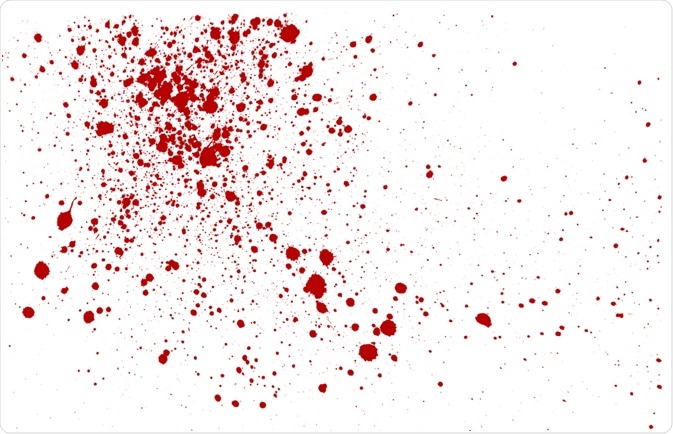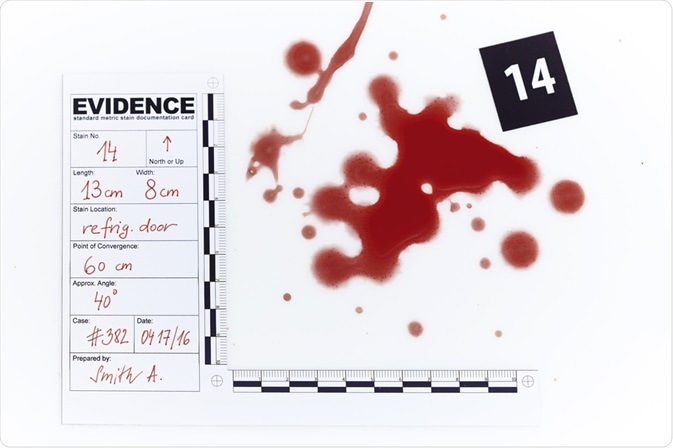In general, bloodstain pattern analysis (BPA) refers to the collection and subsequent forensic analysis investigation of the size, shape, and distribution patterns of bloodstains found at a crime scene.

Image Credit: akepong srichaichana/Shutterstock.com
Rather than providing information about the victim and/or criminals, bloodstain patterns instead provide forensic investigators with information on the “what and how” of the bloodshed event.
More specifically, data acquired from BPA are used for crime scene reconstruction activities, which goes beyond mere speculation of what may have happened during a crime and instead utilizes evidence, reasoning skills, and investigator expertise to determine what happened.
Composition of blood
To determine how different bloodstain patterns arise, it is important to first understand the composition of blood and its normal behavior under different environmental conditions. As one of the most commonly recovered and therefore important pieces of evidence used in forensic investigations, blood is a mixture that contains plasma, cell fragments, which are otherwise referred to as platelets, as well as red and white cells.
Within the plasma, which is the liquid component of blood, exists various proteins, electrolytes, lipids, and glucose. Under normal conditions, the components of blood will not break apart; however, the application of external forces can result in the deposition of blood into several different bloodstain patterns.
Bloodstain patterns
One of the first ways in which BPA assists during reconstruction activities is through determining what type of bloodstain pattern is present. In general, these patterns can be divided into three different categories including passive drop, spatter, and special bloodstain configuration patterns.
Table 1 provides a brief overview of the specific characteristics associated with both passive and spatter bloodstain patterns.
|
Passive
|
Spatter
|
|
Spherical/circular drops
|
Result of force
|
|
Dried and sticky drops on surfaces
|
Size of splatters indicate force intensity
|
|
Blood drops with tails
|
Blunt force trauma, gunshots, explosions, collisions
|
Table 1: Characteristics associated with passive and spatter bloodstain patterns.
Passive bloodstain patterns
As blood drops from its source, the surface tension of this liquid causes these drops to be spherical. As the distance between the blood source and the target source increases, the diameter of the bloodstain will also increase until the terminal velocity of the blood drop is reached. Once the blood drop reaches this terminal velocity, the size of the bloodstain will become constant.
When investigating bloodstain patterns at the scene of the crime, forensic investigators can therefore measure the diameters of bloodstains to determine whether the bleeding individual was standing, being held away from the ground, or was closer to the ground.
In addition to this distinct shape, blood drops are highly viscous and exhibit an adhesive quality that causes small amounts to blood to stick to most surfaces and subsequently dry upon contact. The adhesion of blood drops onto target surfaces can also be determined by the texture of the surface. For example, circular stain patterns often arise on hard and nonporous surfaces whereas spatter stains with rough edges will often be found on softer and more porous surfaces.
In addition to spherical or circular blood drops, it is also common for forensic investigators to identify trails of blood at crime scenes. Typically, the tail of a bloodstain will provide information regarding the directionality of a bloodstain pattern, which ultimately provides information during reconstruction activities on where the bloodshed occurred.
It should be noted that the extra tail present at the end of a bloodstain reflects the bounce effect of the drop of blood; therefore, this length is not included during bloodstain width measurements.
Spatter bloodstain patterns
As compared to passive bloodstain patterns, which typically fall as drops as a result of gravity, spatter bloodstain patterns often arise due to additional force or motion to the bleeding source. Within the category of spatter bloodstain patterns includes impacted bloodstain patterns, which indicate that a much more energetic force was used to cause the blood to break into smaller sized blood spatters or spheres.
The amount of energy involved in the force will determine the size of the blood spatters. More specifically, smaller patterns indicate that a greater amount of force was used. Typically, impacted blood spatter can be classified as medium- or high-force impact spatters. Medium-force impact spatters, which are often the result of blunt or sharp force trauma, will typically exhibit blood drops that are much smaller than those seen in passive bloodstain patterns.
Comparatively, high-force impact spatters, which have a mist-like appearance, are often the result of firearms, but can also occur when explosions or high-speed collisions occur.

Image Credit: Couperfield/Shutterstock.com
Advancing BPA techniques
An accurate BPA will not only involve the procurement of information regarding a single stain but will also consist of appropriate documentation of the entire surrounding area where the bloodstain was identified. Many of the crime scenes that utilized traditional photographic documentation of bloodstain patterns have led to incorrect conclusions.
Such limitations have led researchers to turn to three-dimensional (3D) and optical sensing techniques. The most common 3D technique used during crime scene investigations is based on laser scanning technology that creates complete digitization of the scanner’s surroundings. To complement the data acquired by 3D laser scanning, forensic investigators will often utilize commercial software like Faro Scene, which incorporates traditional photographs with 3D data.
Recent efforts have been made to create a 3D multi-resolution scanning platform that integrates multiple laser scans to obtain information on the bloodstain pattern from different positions. More specifically, this model enables forensic investigators to virtually explore a crime scene to provide them with a more realistic understanding of the bloodstain pattern, as well as any surrounding factors that can be used to determine specific details on the crime that was committed.
References and Further Reading
- Miller, M. T., & Massey, P. (2019). Chapter 8 Reconstruction Activities. In: The Crime Scene. 2nd ed; 179-227. doi:10.1016/C2016-0-04393-0.
- Holowko, E., Januszkiewicz, K., Bolewicki, P., et al. (2016). Application of multi-resolution 3D techniques in crime scene documentation with bloodstain pattern analysis. Forensic Science International 267; 218-227. doi:10.1016/j.forsciint.2016.08.036.
- Attinger, D., Liu, Y., Faflak, R., Rao, Y., et al. (2019). A data set of bloodstain patterns for teaching and research in bloodstain pattern analysis: Gunshot backspatters. Data in Brief 22; 269-278. doi:10.1016/j.dib.2018.11.075.
Last Updated: Sep 25, 2020